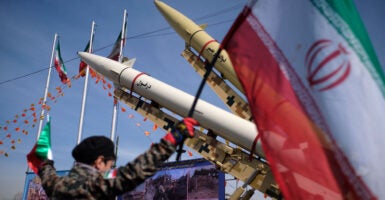With so much discussion about Iran’s provocative nuclear activities and the Biden administration’s contemplation of rejoining the problem-ridden Iran nuclear deal (or Joint Comprehensive Plan of Action), other issues with Iran are being overshadowed.
Its missile program is surely one.
For instance, few might realize that Iran has the largest missile arsenal—which includes ballistic missiles and cruise missiles—in the Middle East, posing a significant regional threat to U.S. allies, partners, and, of course, American forces on duty there.
Indeed, we cannot forget that a little over a year ago, more than 10 Iranian ballistic missiles armed with high explosives struck the Ain al-Asad base in Iraq, injuring a significant number of U.S. troops posted there.
And while Iran has been fraying nerves with its long-standing and repeated violations of the Iran nuclear deal, such as increasing levels of uranium enrichment, it has also been advancing its missile programs, including its space launch vehicle program.
Of course, the Obama-era Iran nuclear deal did not capture Tehran’s ongoing development of ballistic missiles. In fact, U.N. Security Council Resolution 2231, which endorsed the nuclear deal, weakened the missile language of the previous U.N. Security Council Resolution 1929.
Resolution 2231 actually relaxed the language in Resolution 1929 that prohibited “any activity related to ballistic missiles capable of delivering nuclear weapons,” to language that merely “called upon” Iran to refrain from activities “related to ballistic missiles designed to be capable of delivering nuclear weapons.”
Naturally, Tehran has taken advantage of this rhetorically and practically, viewing the “called upon” language as a suggestion rather than a requirement to halt nuclear-capable missile development.
The Iranian space program, which Tehran insists is a peaceful undertaking, is rather a likely cover for an intercontinental ballistic missile program that might someday carry a nuclear weapon.
For instance, last April, Tehran’s paramilitary Islamic Revolutionary Guard Corps launched Iran’s first military reconnaissance satellite into space, revealing the distinct military nature of its space program.
As noted in the Defense Intelligence Agency’s 2019 “Iran Military Power” report, “Progress in Iran’s space program could shorten a pathway to an ICBM because [space launch vehicles] use inherently similar technologies.”
And in early February, according to Iran’s Defense Ministry and other Iranian state news sources, Tehran launched another space launch vehicle, this time with three stages and possibly even more powerful, solid, and liquid-fueled engines.
Of course, setting aside Iran’s space launches and possible ICBM programs, Tehran is already able to reach all of the Middle East and parts of southeastern Europe with its existing longer-range ballistic missiles.
It gets worse.
Iran is also reportedly working (again) with, and receiving assistance from, North Korea to develop its long-range missile program. Pyongyang and Tehran may also be cooperating on their space and nuclear programs.
This situation is significant since North Korea is already a nuclear weapons state with a highly-capable ballistic missile arsenal—including ICBMs—and both Pyongyang and Tehran see Washington as an enemy.
Unfortunately, missile, space, and possibly nuclear weapon cooperation between Tehran and Pyongyang could significantly shorten the timelines Iran would require to develop and field nuclear-armed ICBMs capable of reaching the U.S. homeland.
Stopping Iran from developing nuclear weapons is a clear national security imperative for the United States—and others.
In order to prevent Tehran from developing weapon systems to deliver these same nuclear weapons—in the region or beyond—we must avoid making the dangerous mistake of returning to the Iran nuclear deal as currently constructed.
This article has been updated to include information on the Ain al-Asad base and to clarify language about U.N. Security Council Resolutions 2231 and 1929.
Have an opinion about this article? To sound off, please email [email protected] and we will consider publishing your remarks in our regular “We Hear You” feature.






























